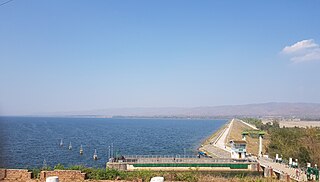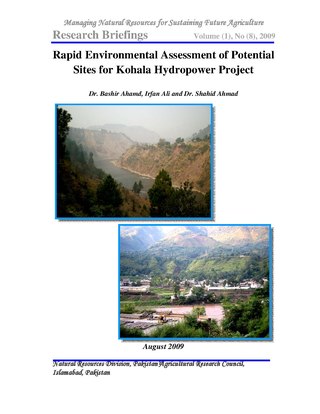
Tarbela Dam is an earth-filled dam along the Indus River in Pakistan's Khyber Pakhtunkhwa province. It is located mainly in the Swabi District Tehsil Topi of the province. It is about 20 km (10 mi) from the city of Swabi KPK, 105 km (65 mi) northwest of Islamabad, and 125 km (80 mi) east of Peshawar. It is the largest earth-filled dam in the world. The dam is 143 metres (470 ft) high above the riverbed and its reservoir, Tarbela Lake, has a surface area of approximately 250 square kilometres (97 sq mi).

There are almost 200 large dams in Myanmar. Myanmar (Burma) has a large hydroelectric power potential of 39,000 megawatts (52,000,000 hp), although the economical exploitable potential is about 37,000 megawatts (50,000,000 hp). Between 1990 and 2002, the country tripled its installed capacity of hydro plants, increasing from 253 megawatts (339,000 hp) to 745 megawatts (999,000 hp). Total installed capacity in 2010 is at least 2,449 megawatts (3,284,000 hp) MW, 6% of potential. Several large dams are planned to increase future hydro utilization.

The Neelum–Jhelum Hydropower Plant is part of a run-of-the-river hydroelectric power project in Azad Kashmir (AJK) designed to divert water from the Neelum River to a power station on the Jhelum River. The power station is located 42 km (26 mi) south of Muzaffarabad, and has an installed capacity of 969 MW. Construction on the project began in 2008 after a Chinese consortium was awarded the construction contract in July 2007. After many years of delays, the first generator was commissioned in April 2018 and the entire project was completed in August 2018 when the fourth and last unit was synchronized with the national grid on 13 August and attained its maximum generation capacity of 969 MW on 14 August 2018. It will generate 5,150 GWh per year at the levelised tariff of Rs 13.50 per unit for 30 years.
The Jufudu Dam (居甫渡大坝) is a gravity dam on the Lixian River, bordering the counties of Yuanjiang and Mojiang in Yunnan Province, China. It is located 56 km (35 mi) from Pu'er City. The primary purpose of the dam is hydroelectric power generation and it supports a 285 MW power station. Construction began in September 2004, and the three 95 MW generators were commissioned in December 2008. It is the fifth dam in the Lixian cascade.
The Nandipur Power Project is a 425 MW combined cycle thermal power plant situated at Nandipur near Gujranwala in the Punjab province of Pakistan. Being constructed by the China Dongfang Electric Corporation, the project was completed in March 2015. The initial cost of the project was Rs. 27 billion, but this escalated during the revised project cycle-1 and totalled Rs. 58.42 bn at completion. The power plant faced a series of hiccups during and after launching its commercial operations. Prior and after construction, the project continued to attract a number of court cases, inquiries, investigations, audits, and political and commercial disputes. The plant collapsed after 5 days of operation, launching a series of inquiries ordered by then prime minister Nawaz Sharif.
The Khan Khwar Hydropower Plant is a run-of-the-river project located near the town of Besham in the Shangla District of the Khyber Pakhtunkhwa province of Pakistan. It is situated on the Khan Khwar River, a right bank tributary of the Indus River. It is approximately 265 km from the federal capital of Islamabad and 350 km from the provincial capital of Peshawar.
The Allai Khwar Hydropower Plant is a run-of-the-river, high head project of 687 metres, located in the Battagram District on the Allai Khwar River, a left bank tributary of the Indus River in Khyber Pakhtunkhwa province, Pakistan. It is approximately 245 km from the federal capital of Islamabad and 330 km from the provincial capital of Peshawar.

China–Pakistan Economic Corridor (CPEC) is a 3,000 km Chinese infrastructure network project undertaken in Pakistan. This sea-and-land-based corridor is aimed to secure and reduce the passage for China's energy imports from the Middle East by avoiding the existing route from the Straits of Malacca between Malaysia and Indonesia, which in case of war could be blocked and thus hamper the Chinese energy dependent economic avenues. Developing a deep water port at Gwadar in the Arabian Sea and a well built road and rail line from this port to Xinjiang Province in western China would be a shortcut for boosting the trade between Europe and China. In Pakistan, it aims to overcome an electricity shortfall, infrastructural development and modernize transportation networks. Along with shifting it from an agricultural based economic structure to industrial based.
The Duber Khwar Hydropower Plant is located near the town of Pattan in Kohistan, Khyber Pakhtunkhwa, Pakistan on the Duber Khwar River, a right bank tributary of the Indus River. It is approximately 340 km NW from Islamabad, the federal capital of Pakistan.
The Dasu Dam is a large hydroelectric gravity dam currently under construction on the Indus River near Dasu in Kohistan District, Khyber Pakhtunkhwa Province, Pakistan. It is developed by Pakistan Water and Power Development Authority (Wapda), as a key component of the company's Water Vision 2025. The project was started in 2019 but faced a delay due to funds and land acquisition disputes. Work resumed in 2020 after land acquisition and arrangements of funding facility, the World Bank agreed to contributed $700 million of the $4.2 billion as the government of Imran Khan decided to proceed ahead with the construction of the project, as part of his vision of reducing Pakistan's reliance on non-renewable energy.

The Kohala Hydropower Project is a proposed run-of-the-river, high head project of 316 meters that will be located near Kohala, in Azad Kashmir. In 2020 the project's agreement was finalised later it was formally signed in a ceremony attended by the Pakistani Prime Minister Imran khan, and Chinese ambassador.
The Quaid-e-Azam Solar Park is a photovoltaic power station in Bahawalpur, Punjab, Pakistan, named in honor of Quaid-e-Azam Muhammad Ali Jinnah, the Founder of Pakistan. It is a 400 MW solar facility spanning an area of 8 km2 and hosting 1.6 million solar modules. The initial phase of the project was constructed by the Government of Punjab through a 100% owned subsidiary QA Solar in May 2015 at a cost of $131 million. On 5 May 2015, the then Prime Minister of Pakistan Nawaz Sharif inaugurated the first 100 MW project and dedicated it to the nation. Subsequent expansion was done in public-private partnership with Appolo Solar Development Pakistan Limited, Best Green Energy Pakistan Limited and Crest Energy Pakistan Limited each installing a 100 MW unit. The next phase of 100 MW will be installed by Zorlu Solar Pakistan (Pvt.) Limited, making it a 500 MW facility. Total planned capacity of the solar park is 1,000 MW.

The Azad Pattan Hydropower Project is a 700.7 MW hydroelectric power station on the Jhelum River roughly 7 km upstream of Azad Pattan Bridge in the Sudhanoti District, Azad Jammu and Kashmir, Pakistan and 90 km from Islamabad, the capital city of Pakistan. The project is scheduled for completion by 2026. In July 2020, the project's $1.5 billion investment agreement was signed between Chinese state-owned China Gezhouba Group and Pakistan, in a ceremony attended by Prime Minister Imran Khan and senior government ministers.
The Karot Hydropower Project is an asphalt-core rockfill gravity dam in Pakistan, with an installed capacity of 720 MW. The project is sponsored by Chinese state-owned company China Three Gorges Corporation (CTG).
The Engro Thar Coal Power Project (Thar-ll) is a coal-fired power plant developed as part of the China–Pakistan Economic Corridor by Sindh Engro Coal Mining Company and China Machinery Engineering Corporation in the Thar Block-II of the Thar Coalfield, Tharparkar District, Sindh, Pakistan 25 kilometers from the town of Islamkot near the village of Singharo-Bitra.
The Moragolla Dam is a planned hydroelectric dam in Moragolla, Sri Lanka. The dam is to be 35 m (115 ft) high and is planned to create the 1,980,000 m3 (70,000,000 cu ft) Moragolla Reservoir with a maximum supply level at 548 m (1,798 ft) MSL. Upon completion, the Moragolla Power Station would have a gross installed capacity of 30 megawatts from two francis turbines, capable of generating approximately 85 GWh annually.
Lower Spat Gah Hydropower Project is a hydroelectric power project located in Kohistan, Khyber Pakhtunkhwa province of Pakistan.






